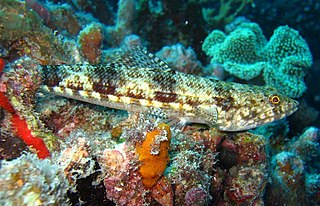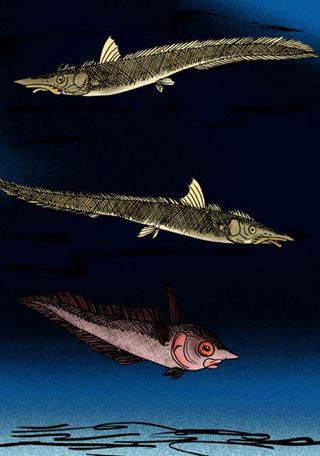
Aulopiformes is a diverse order of marine ray-finned fish consisting of some 15 extant and several prehistoric families with about 45 genera and over 230 species. The common names grinners, lizardfishes and allies, or aulopiforms are sometimes used for this group. The scientific name means "Aulopus-shaped", from Aulopus + the standard fish order suffix "-formes". It ultimately derives from Ancient Greek aulós + Latin forma, the former in reference to the elongated shape of many aulopiforms.

Lancetfishes are large oceanic predatory ray-finned fishes in the genus Alepisaurus in the monogeneric family Alepisauridae.

Carcharias is a genus of mackerel sharks belonging to the family Odontaspididae. Once bearing many prehistoric species, all have gone extinct with the exception of the critically endangered sand tiger shark.

Scomber is a genus of fish in the family Scombridae living in the open ocean found in Atlantic, Indian and Pacific Ocean. The genus Scomber and the genus Rastrelliger comprise the tribe Scombrini, known as the "true mackerels". These fishes have an elongated body, highly streamlined, muscular and agile. The eyes are large, the head is elongated, with a big mouth provided with teeth. They have two triangular dorsal fins, with some stabilizing fins along the caudal peduncle. The basic color is blue-green with a silvery white belly and a darker back, usually black mottled.

Cimolichthys is an extinct genus of large predatory marine aulopiform ray-finned fish known worldwide from the Late Cretaceous. It is the only member of the family Cimolichthyidae.

Apateodus is a genus of prehistoric marine ray-finned fish which was described by Woodward in 1901. It was a relative of modern lizardfish and lancetfish in the order Aulopiformes, and one of a number of prominent nektonic aulopiforms of Cretaceous marine ecosystems.

Argillichthys is an extinct marine lizardfish known from the Lower Eocene. It contains a single species, A. toombsi, from the Ypresian-aged London Clay Formation in England. It is known from a skull. It is thought to be a stem-member of Synodontidae.

Aetiocetus is a genus of extinct basal mysticete, or baleen whale that lived 33.9 to 23.03 million years ago, in the Oligocene in the North Pacific ocean, around Japan, Mexico, and Oregon, U.S. It was first described by Douglas Emlong in 1966 and currently contains known four species, A. cotylalveus, A. polydentatus, A. tomitai, and A. weltoni. These whales are remarkable for their retention of teeth and presence of nutrient foramina, indicating that they possessed baleen. Thus, Aetiocetus represents the transition from teeth to baleen in Oligocene mysticetes. Baleen is a highly derived character, or synapomorphy, of mysticetes, and is a keratinous structure that grows from the palate, or roof of the mouth, of the whale. The presence of baleen is inferred from the fossil record in the skull of Aetiocetus. Aetiocetus is known from both sides of the Pacific Ocean: it was first documented in Oregon, United States, but it is also known from Japan and Mexico. The genus is currently constrained to the Northern hemisphere and has little value in biostratigraphic studies of the Oligocene due to its limited occurrences across the Pacific.

Caranx is a genus of tropical to subtropical marine fishes in the jack family Carangidae, commonly known as jacks, trevallies and kingfishes. They are moderate- to large-sized, deep-bodied fishes which are distinguished from other carangid genera by specific gill raker, fin ray and dentition characteristics. The genus is represented in the Pacific, Indian and Atlantic Oceans, inhabiting both inshore and offshore regions, ranging from estuaries and bays to deep reefs and offshore islands. All species are powerful predators, taking a variety of fish, crustaceans and cephalopods, while they in turn are prey to larger pelagic fishes and sharks. A number of fish in the genus have a reputation as powerful gamefish and are highly sought by anglers. They often make up high amounts of the catch in various fisheries, but are generally considered poor to fair table fishes.

Laytonia is an extinct genus of prehistoric halosaur that lived in deep water off the North American Pacific Coast from the Zemorrian Epoch until during the Upper Miocene subepoch, when tectonic uplift effectively destroyed the genus' habitat by making the deep water too shallow.
Carpathichthys is an extinct genus of prehistoric slickhead fish from the Oligocene. It contains a single species, C. polonicus, from the Menilite Formation in the Carpathian Flysch Belt of Poland, in what was formerly the Paratethys Sea.

Dapalis is an extinct genus of prehistoric glassfish known from the Late Cretaceous to the Early Miocene. It is known from both freshwater and marine habitats of India, Australia, New Zealand, and much of mainland Europe.

Cylindracanthus is an extinct, enigmatic genus of marine ray-finned fish with fossils known throughout North America, Europe, Asia and Africa from the Late Cretaceous to the late Eocene, with potential Oligocene records and a possible Miocene record also known. It is exclusively known from its distinctive partial remains, which are long cylindrical bony spines that are usually considered rostrum fragments, as well as some associated teeth. These spines are abundant & widespread throughout this timespan, and are useful indicators of a nearshore marine environment, but the taxonomic identity of the fish is still highly uncertain and debated.

Megapiranha is an extinct serrasalmid characin fish from the Late Miocene Ituzaingó Formation of Argentina, described in 2009. The type species is M. paranensis. It is thought to have been about 71 centimetres (28 in) in length and 10 kilograms (22 lb) in weight. The holotype consists only of premaxillae and a zigzag tooth row; the rest of its body is unknown. This dentition is reminiscent of both the double-row seen in pacus, and the single row seen in the teeth of modern piranhas, suggesting that M. paranensis is a transitional form. Its bite force is estimated between 1,240–4,749 N (279–1,068 lbf).

Asterotrygon is an extinct genus of stingray from the Eocene Green River Formation in Wyoming. Several complete skeletons representing juveniles, adults, males and females have been uncovered from the late early Eocene Fossil Butte Member of the formation. The type and only species, A. maloneyi, was named in 2004 on the basis of these fossils. Another stingray, Heliobatis, is also known from the formation. Asterotrygon is a primitive stingray closely related to the living family Urolophidae whose ancestors likely originated in the Indo-Pacific. It lived in Fossil Lake, a body of water that existed in a subtropical mountainous region for only about 2 million years.
Pterodromoides is an extinct genus of fulmarine petrel dating from the Late Miocene. It contains a single species, P. minoricensis. Its fossil remains were first discovered at the Punta Nati palaeontological site on the island of Menorca in the Balearic archipelago of the western Mediterranean. An additional specimen from North Carolina, USA has also been referred to this species, suggesting it lived across the North Atlantic. It was described in 2001, with the authors justifying the creation of a new genus by the large orbitonasal opening and characters of the postcranial skeleton, despite the similarity of the cranial osteology to that of Pagodroma.

Alepisaurus paronai is an extinct species of lancetfish known from a fossil skull found in Middle Miocene-aged strata in Piedmont, Italy. The skull is very similar in anatomy and dimensions to that of the extant long-snouted lancetfish. The specific name honors one Professor Carlo Fabrizio Parona, a friend and personal mentor of its describer, Geremia d'Erasmo.

Aphaenogaster dlusskyana is an extinct species of ant in the subfamily Myrmicinae known from a single Middle Eocene fossil found in amber on Sakhalin. At the time of description A. dlusskyana was one of eight ant species known from Sakhalin fossil.
Humboldtichthys is an extinct genus of glass knifefishes from the Miocene Yecua Formation of Bolivia. A single species is currently recognized: Humboldtichthys kirschbaumi.

Plotopterum is an extinct genus of flightless seabird of the family Plotopteridae, native to the North Pacific during the Late Oligocene and the Early Miocene. The only described species is Plotopterum joaquinensis.

















